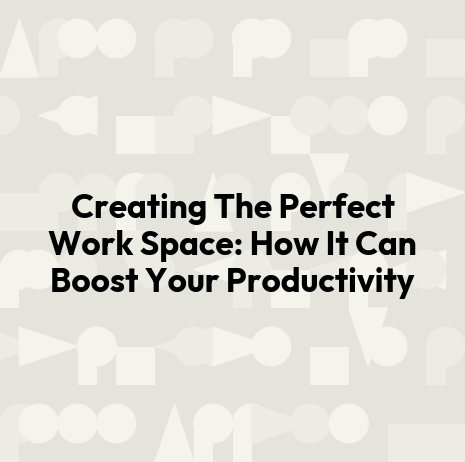- Published on:
Creating The Perfect Work Space: How It Can Boost Your Productivity
- Authors


- Name
- Ethan Thompson
When it comes to productivity, the environment we work in can make a huge difference. As someone who spends most of my day at work, I know firsthand how important it is to have a space that's comfortable and conducive to getting things done. Whether you work from home or in an office, creating the perfect workspace can help you be more productive and efficient.
In this article, we'll be exploring different ways you can optimize your workspace to boost your productivity. We'll start by assessing your current workspace and identifying areas where improvements can be made. Then, we'll delve into some practical tips for optimizing lighting, choosing the right desk and chair, personalizing your space, and establishing a routine. By implementing these strategies, you'll be well on your way to creating a workspace that not only looks great but also helps you stay focused and motivated throughout the day.
Table of Contents
- Assess Your Current Workspace
- Optimize Your Lighting
- Choose the Right Desk and Chair
- Personalize Your Space
- Establish and Maintain a Routine
- Frequently Asked Questions
- How can the color of my workspace affect my productivity?
- What are some tips for organizing my workspace to maximize efficiency?
- Is it better to have a quiet or a noisy workspace for optimal productivity?
- How can adding plants to my workspace improve my productivity?
- Are there any specific scents that can help improve productivity in the workspace?
- Conclusion
Assess Your Current Workspace
Take a moment to consider where we currently work and how it makes us feel. It's important to evaluate ergonomics and eliminate distractions in our workspace as these can significantly impact our productivity. Is our chair comfortable? Is the desk at the right height? Are the computer screen and keyboard positioned optimally for our posture and eyesight? Addressing these questions can help us create a more conducive environment for focused work.
In addition, eliminating distractions is crucial for creating an ideal workspace. Are there unnecessary items on our desk that draw our attention away from work? Do we receive constant notifications on our phone or computer that interrupt us while working? By identifying such distractions, we can take steps to remove or minimize them so that we can focus better. Now let's move onto optimizing lighting in your workspace.
Optimize Your Lighting
To really shine in your work, make sure your lighting is like a ray of sunshine on a cloudy day. Lighting can affect our productivity and mood, so it's important to optimize the lighting in our workspace. One key factor to consider is natural vs artificial lighting. Natural light has been proven to improve mood and energy levels, while also reducing eye strain and headaches. If possible, position your desk near a window or invest in skylights to bring more natural light into your space.
Another factor to consider is color temperature choices for artificial lighting. The color temperature of the light can impact how awake or relaxed we feel. Cooler temperatures (5000K-6500K) are great for tasks that require focus and concentration, while warmer temperatures (2700K-3000K) create a cozy atmosphere that's perfect for relaxing after work. By taking these factors into consideration when optimizing your workspace lighting, you'll be able to create an environment that will help you be productive and feel good while working.
When it comes to setting up the perfect workspace, choosing the right desk and chair is crucial.
Choose the Right Desk and Chair
You'll want to make sure your workspace is comfortable by choosing a desk and chair that will support you throughout the day. Your desk should have enough space for your computer, paperwork, and any other tools you use frequently. It should also be at a height that allows you to comfortably type and view your screen without straining your neck or shoulders. Consider investing in an adjustable standing desk that can help improve circulation and reduce the risk of sitting-related health problems.
In addition to a suitable desk, having an ergonomic chair is crucial for maintaining good posture and reducing back pain. Look for chairs with adjustable seat height, lumbar support, and armrests to ensure maximum comfort during long work hours. You may also want to consider adding ergonomic accessories such as footrests or wrist rests to further customize your workspace. With the right combination of furniture and accessories, you can create a comfortable environment that promotes productivity and overall well-being. Now let's move on to how you can personalize your space even further.
Personalize Your Space
Personalizing your workspace can have a significant impact on your overall satisfaction at work, with studies showing that employees who feel connected to their surroundings are 15% more productive than those who don't. Adding personal touches to your desk and office space can make you feel more comfortable and relaxed, which in turn can help boost creativity and productivity. Here are three Feng Shui tips for personalizing your workspace:
Incorporate natural elements: Bringing in plants or small water features can create a calming environment that helps reduce stress.
Use colors that inspire you: Choose colors that promote focus and productivity, such as blue or green, or ones that bring you joy and inspiration.
Display meaningful items: Personal photos, quotes, or mementos can serve as reminders of what's important to you and help motivate you throughout the day.
By incorporating these simple tips into your work environment, you'll be able to create a space that feels uniquely yours and supports your productivity goals. Establishing an inspiring work routine is another essential step toward achieving success at work.
Establish and Maintain a Routine
Establishing and maintaining a daily routine can be key to achieving success in your work, like a roadmap that guides you through the day. Creating a routine provides structure and helps manage time effectively, which is crucial for productivity. By having a set schedule, it becomes easier to prioritize tasks and allocate time accordingly. This leads to less procrastination and more focus on completing important tasks.
Creating a routine involves setting clear goals for the day, week or month ahead. To achieve this, one can use tools such as calendars or sticky notes to help plan out tasks in advance. It's also important to factor in breaks throughout the day, as taking short breaks can actually improve concentration levels rather than hinder them. Additionally, establishing boundaries around work hours and sticking to them can help create a healthy work-life balance which ultimately leads to better overall productivity. In summary, creating a routine provides numerous benefits including improved time management skills and increased productivity levels; all of which are essential components of achieving professional success.
| TIPS | BENEFITS |
|---|---|
| Prioritize tasks based on importance | Less procrastination |
| Use scheduling tools like calendars | Better time management |
| Take regular breaks throughout the day | Improved concentration levels |
| Establish boundaries around work hours | Healthier work-life balance |
Frequently Asked Questions
How can the color of my workspace affect my productivity?
Color psychology plays a significant role in influencing our moods and behavior, and the color of your workspace can have a profound impact on your productivity. Blue is known to promote calmness and focus, while yellow stimulates creativity and optimism. Lighting choices are also crucial when it comes to creating an ideal work environment as poor lighting can cause eye strain, headaches, and fatigue. Ergonomic furniture such as standing desks can improve posture and reduce discomfort associated with prolonged sitting. Overall, incorporating the right color scheme along with proper lighting choices and ergonomic furniture can go a long way in enhancing your productivity at work.
What are some tips for organizing my workspace to maximize efficiency?
When it comes to organizing our workspaces, the key is to keep it simple and efficient. A minimalist design paired with ergonomic furniture can do wonders for our productivity. Studies show that a cluttered workspace can lead to increased stress levels and decreased efficiency, so keeping things tidy is important. In addition, implementing a digital organization system and going paperless can also save time and reduce the amount of physical clutter in our space. By taking small steps towards creating an organized workspace, we can improve our focus and increase productivity throughout the day.
Is it better to have a quiet or a noisy workspace for optimal productivity?
When it comes to productivity, the debate between music or silence and open office or cubicles is ongoing. Some people prefer complete silence to maintain focus while others find that listening to music helps them concentrate better. As for office layout, open offices are often seen as more collaborative and conducive to teamwork, while cubicles provide a sense of privacy and fewer distractions. Ultimately, the best option depends on personal preference and job requirements. It's important to experiment with different environments to determine what works best for you in terms of noise level and workspace design.
How can adding plants to my workspace improve my productivity?
Incorporating personal touches in your workspace can greatly improve productivity. One of the easiest ways to achieve this is by adding plants. As the old adage goes, "Bringing nature indoors brings life to a room". Plants not only add aesthetic appeal but are also proven to have numerous benefits on air quality and natural light. Not only do they filter toxins from the air, but they also increase oxygen levels which can result in increased alertness and concentration. So don't hesitate to add a few green friends to your desk!
Are there any specific scents that can help improve productivity in the workspace?
Aromatherapy benefits have been long-known for their ability to stimulate our senses and improve our mood. In the workspace, certain fragrances can help increase productivity by promoting alertness, focus, and relaxation. For instance, peppermint has been shown to boost concentration and memory retention while lavender can help reduce stress levels and promote calmness. Other stimulating fragrances such as lemon or grapefruit can uplift your mood and energize your mind. Incorporating these scents through diffusers or candles can enhance your work environment and help you stay focused throughout the day.
Conclusion
So there you have it, the key to boosting your productivity lies in creating the perfect workspace. By assessing your current space and making necessary adjustments such as optimizing lighting, choosing the right desk and chair, personalizing your area, and establishing a routine, you can create an environment that fosters creativity and productivity.
Remember that Rome wasn't built in a day - take small steps towards improving your workspace each day. Don't be afraid to experiment with different arrangements or decorations until you find what works best for you. As the saying goes, "Rome wasn't built in a day," meaning that great accomplishments take time and effort. But by investing in creating the perfect workspace, you'll reap countless benefits that will pay off both professionally and personally. So go ahead and get started on transforming your workspace into a place where productivity thrives!